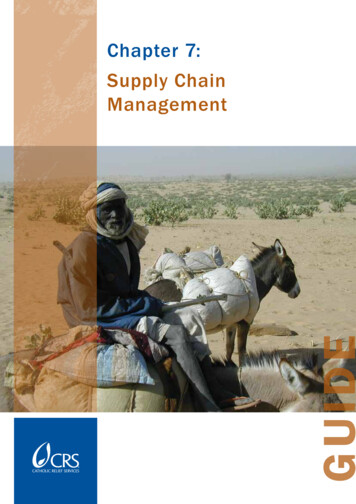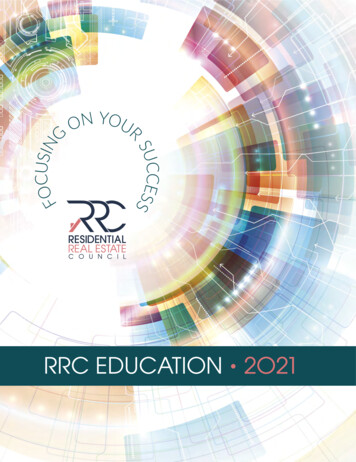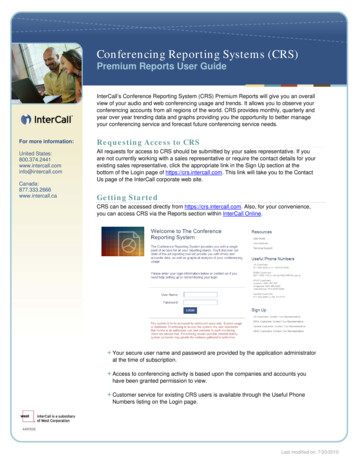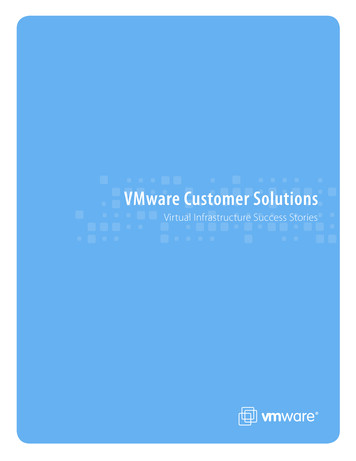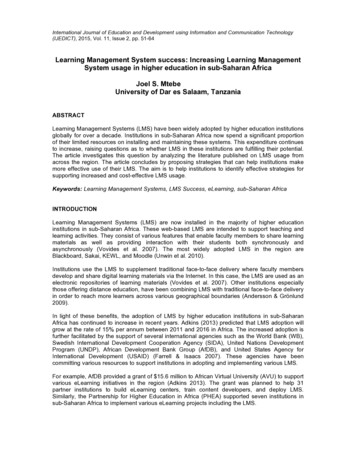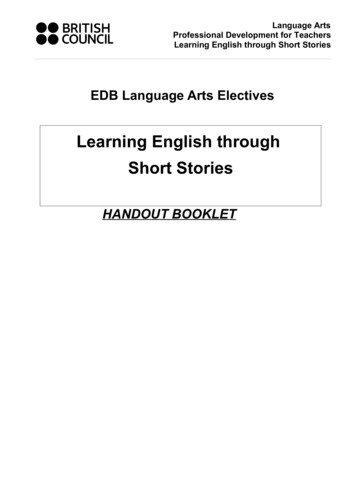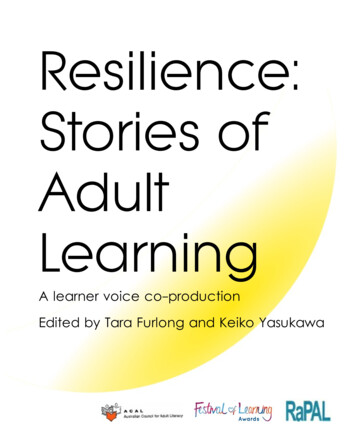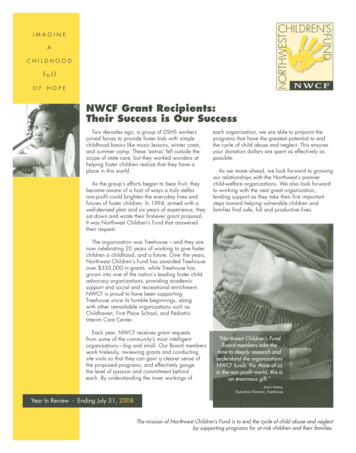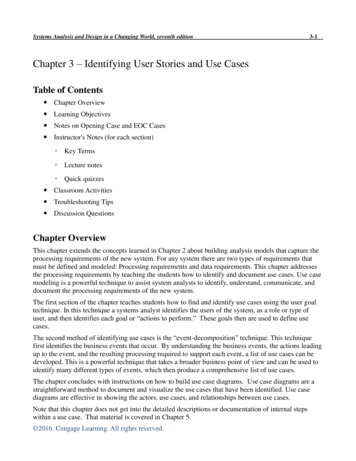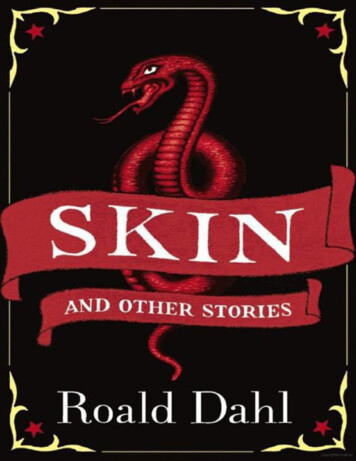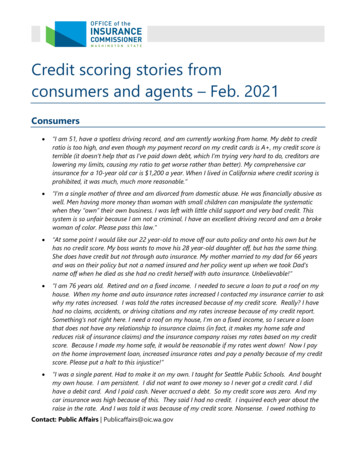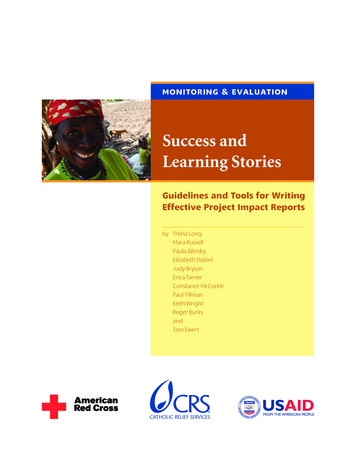
Transcription
Mo n ito rin g & Eva l uati o nSuccess andLearning StoriesGuidelines and Tools for WritingEffective Project Impact Reportsby Trisha LongMara RussellPaula BilinskyElizabeth DalzielJudy BrysonErica TarverConstance McCorklePaul TillmanKeith WrightRoger BurksandTom Ewert
Since 1943, Catholic Relief Services (CRS) has held the privilege of serving the poorand disadvantaged overseas. Without regard to race, creed, or nationality, CRSprovides emergency relief in the wake of natural and manmade disasters. Throughdevelopment projects in fields such as education, peace and justice, agriculture,microfinance, health and HIV/AIDS, CRS works to uphold human dignity andpromote better standards of living. CRS also works throughout the United Statesto expand the knowledge and action of Catholics and others interested in issues ofinternational peace and justice. Our programs and resources respond to the U.S.Bishops’ call to live in solidarity—as one human family—across borders, over oceans,and through differences in language, culture and economic condition.The American Red Cross helps vulnerable people around the world prevent, preparefor, and respond to disasters, complex humanitarian emergencies, and life-threateninghealth conditions through global initiatives and community-based programs. With afocus on global health, disaster preparedness and response, restoring family links, andthe dissemination of international humanitarian law, the American Red Cross providesrapid, effective, and large-scale humanitarian assistance to those in need. To achieveour goals, the American Red Cross works with our partners in the International RedCross and Red Crescent Movement and other international relief and developmentagencies to build local capacities, mobilize and empower communities, and establishpartnerships. Our largest program is currently the Tsunami Recovery Program,which is improving community health and preventing disease outbreaks, supportingcommunities as they rebuild their lives and reestablish their livelihoods, and helpingaffected Red Cross and Red Crescent Societies and their communities develop disasterpreparedness capabilities.Published in 2008 by:Catholic Relief Services228 W. Lexington StreetBaltimore, MD 21201-3413USAAmerican Red Cross2025 E Street, NWWashington, DC 20006USAAuthors: Trisha Long, Mara Russell, Paula Bilinsky, Elizabeth Dalziel, Judy Bryson,Erica Tarver, Constance McCorkle, Paul Tillman, Keith Wright, Roger Burks,and Tom EwertSeries Editor: Guy Sharrock (CRS)Readers/Editors: Cynthia Green, Joe Schultz (CRS), and Dina TowbinGraphic Designer: Jeanne IvyCover Photograph: David SnyderThis module was produced by CRS and the American Red Cross with financial supportfrom the United States Agency for International Development (USAID) Food for Peace(FFP) grants: CRS Institutional Capacity Building Grant (AFP-A-00-03-00015-00) andAmerican Red Cross Institutional Capacity Building Grant (AFP-A-00-00007-00).The views expressed in this document are those of the author and do not necessarilyrepresent those of the USAID or FFP.To access the full series, please visit: www.crs.org or www.redcross.org.
ng Success and Learning Stories1Introduction3Instructions5Recommendations for Title II Success Story Writing6Basic Project Information Datasheet7Sample: Story Information Form11Sample Story 1: Awar’s Story with Comments—Rated “Fair”12Sample Story 2: Awar’s Story with Comments—Rated “Good”Tools & Resources Annexes13Annex I Basic Project Information Form14Annex II Story Information Form
PrefaceMonitoring and evaluation are core responsibilities of American Red Crossand Catholic Relief Services (CRS) program managers and help ensure qualityin our programming. The Success and Learning Stories module is one in a seriesof M&E training and capacity-building modules that the American Red Crossand CRS have agreed to collaborate on under their respective InstitutionalCapacity Building Grants. These modules are designed to respond to fieldidentified needs for specific guidance and tools that do not appear to beavailable in existing publications. Although examples in the modules focus onTitle II programming, the guidance and tools provided have value beyond thefood-security realm.Our intention in producing Success and Learning Stories is to provide readerswith a document that helps them respond to Food for Peace’s (FFP’s) originalrequest for short stories as part of their regular reporting requirements. Themodule provides brief guidance on how to write good impact stories that willaddress the needs of a number of audiences, including FFP. Underlying themodule is a desire to improve the learning associated with the human impactof project implementation.Please send any comments or suggestions for this module to:m&efeedback@crs.org.Recommended citation: Long, Trisha, Mara Russell, Paula Bilinsky, ElizabethDalziel, Judy Bryson, Erica Tarver, Constance McCorkle, Paul Tillman, KeithWright, Roger Burks, and Tom Ewert. 2008. “Success and Learning Stories.”American Red Cross/CRS M&E Module Series. American Red Cross and CRS,Washington, DC, and Baltimore, Maryland.Success and Learning Stories iii
AcknowledgementsMany of the core analytical concepts and tools in this module are based onthe work of Constance McCorkle, the former Senior Technical Advisor onMonitoring and Evaluation for CRS. We wish to also thank Guy Sharrock(CRS/Baltimore) for his various editorial contributions, Velida Dzino (CRS/Bosnia), Stephen Nkoka and Jennifer Lentfer (both formerly with CRS/Malawi), and Patricia McLaughlin (formerly with the American Red Cross/Washington) for reviewing drafts and/or providing information on keyreferences that we have included. Finally, we would like to acknowledgethe work of Dina Towbin (consultant) and Tracy Hightower (formerly withAmerican Red Cross/Washington), whose editorial work helped to shepherdthe document through its final stages, and Joe Schultz and Jeanne Ivy, whowere responsible for the graphical design work.Success and Learning Stories iv
AcronymsCRSCatholic Relief ServicesEOPEmergency Operations ProjectFAMFood Aid ManagementFANTAFood and Nutrition Technical Assistance ProjectFFPUSAID’s Office of Food for PeaceM&EMonitoring and evaluationORTOral rehydration therapyPVOPrivate voluntary organizationSOStrategic objectiveSOWScope of workUSAIDUnited States Agency for International DevelopmentW/HWeight/heightSuccess and Learning Stories v
IntroductionIn Fiscal Year 2003, USAID’s Office of Food for Peace (FFP) requested thatThe module givessuggestions andguidance so that storiescan be prepared in away that consistentlyprovides the type ofimpact information thatwould be most usefulto FFP.short narratives of Title II activities and impacts be included as part ofannual results reports. A number of private voluntary organizations (PVOs),coordinating under the Food Aid Management (FAM) project’s Monitoringand Evaluation (M&E) Working Group, decided to address the need forguidance on how to write clear and consistent impact stories that would servea variety of purposes and audiences, including FFP.To this end, working group members collected a score of stories fromtheir PVOs’ files. These stories were then analyzed for content and styleby, respectively, a member of the group and the head of marketing andcommunication at the respective PVO.1 As anticipated, the sample variedwidely in content, style, and overall quality from program to program andfrom organization to organization. From their analysis of this variation,the two-person team produced preliminary lists of key topics and basicstylistic “do’s and don’t’s.” These items were further analyzed and refined bymembers of the M&E Working Group as a whole, with added inputs fromcommunication and editorial personnel from various PVOs collaborating inthis task.2The working group’s goal was to produce the present package of guidancefor harmonizing the formats of what it termed success and learning stories.The success stories are defined as descriptions of “who, what, when, where,why, and how” a Title II project has succeeded in its objectives and perhapseven had unanticipated positive effects. The learning stories narrate casesof unanticipated project difficulties or negative impacts, how these wereidentified and overcome, and what was learned from the experience that maybe helpful to other projects.1 Dr. Constance M. McCorkle, former Senior Headquarters Technical Advisor for M&E,and Paul Tillman, Senior Director, Marketing, Catholic Relief Services (CRS).2 Task Organizer: Trisha Long; Contributors: Judy Bryson, Erica Tarver, Elizabeth Dalziel,Constance McCorkle, Paul Tillman, Mara Russell, Paula Bilinsky, Keith Wright, Roger Burks,and Tom Ewert.Success and Learning Stories 1
IntroductionThe result is this Success and Learning Stories module. The module givessuggestions and guidance so that stories can be prepared in a way thatconsistently provides the type of impact information that would be mostuseful to FFP for its reporting and other communications needs, while alsofurnishing PVOs with better information to highlight accomplishments tolocal counterparts, private donors, and internal constituencies.The components of the package consist of: Background and instructions A suggested list of “do’s and don’t’s” concerning story information,stylistics, tone, and so on A sample template consisting of questions to be answered so as toprovide the necessary information for a complete and meaningfulnarrative (annex I) Examples of stories written from the sample template (one writtenbetter than the other according to the instructions here) A blank template to be used to write a success or learning story(annex II).Success and Learning Stories 2
InstructionsThe package is largely self-explanatory; but, perhaps a few points should beThe package’s primarypurpose is as a guide ora checklist for field staffto first understand whattype of information isneeded for a good TitleII story, and second, tosystematically collect andrecord that information.noted. For instance, overall, the template asks for: Project-specific and participant-specific information, e.g., what theproject is trying to do, often in a single project component , and howspecific participants have experienced the project’s impact on theirlives Both qualitative and quantitative information, e.g., not only whata project component is trying to do and how certain participantsare affected, but also what is that component’s geographic ordemographic coverage, and how many such participants (or evennon-participants) can be expected to benefit Intended positive impacts, but also unintended positive and negativeimpacts—and in the latter case, what corrections or mitigations arebeing taken.The template is explicitly geared for gathering key details for Title IIsuccess and learning stories by or from those who know them best: projectparticipants and staff in the field. However, this is not to say that others whoare familiar with particular project (e.g., regional or technical support staffor evaluation consultants) cannot use the template as well. Although it wasdesigned with Title II efforts in mind, it can be adapted to many other types ofprojects and programs.The template is also designed to be adaptable to how a PVO typically collects,compiles, and writes up information for its results reports and for otherreporting and outreach purposes. Again, the package’s primary purposeis as a guide or a checklist for field staff to first understand what type ofinformation is needed for a good Title II story, and second, to systematicallycollect and record that information. With regard to collection, it is not alwaysnecessary to interview a participant to fill in the template. But if interviews areconducted, be sure to tell interviewees why the interview is being done andhow the information from it will be used.3Once the template information is collected and recorded, field staff can tryto write up their Title II success and learning stories using the other tools inthe Success and Learning Stories module. In some PVOs, field staff may rely onregional or headquarters staff or consultants to write the stories for them.3 If interviewees do not want their names to appear in the story, pseudonyms (false names)can be used instead.Success and Learning Stories 3
InstructionsTools & ResourcesBasic Project Information FormStory Information FormNo matter which of these routes is taken, however, copies of the completedtemplates should always be shared with headquarters’ communicationunits. Such information is invaluable to them for producing stories and othermaterials aimed at multiple audiences besides just FFP (e.g., other donors, thepublic, and local or other partners around the world).The template can be used as often as deemed necessary by project and PVOheadquarters staff. At a minimum, however, it should be used once a year inpreparation for the annual Title II results reports.Finally, the authors hope that the template will serve as an incentive forproviding story information by clarifying what information is needed;by simplifying the process of collecting and organizing the information;and, above all, by showcasing field staff’s successful work in overcomingdifficulties and achieving project objectives. That said, some PVOs haveprovided staff incentives to provide story information. Examples are: a smallamount of money for an office party upon completion of the story (ies); asmall bonus to the staff who gather the information; alternatively, a trophy orcertificate; in documentation other than FFP reports, perhaps a personal photoand short acknowledgement of the staffers’ work, and so on.Please send your feedback on this module to: m&efeedback@crs.org. It will beused to update and improve the template. Please send your responses to thefollowing questions: Did using this template make writing a Title II success story easier,more difficult, or was there no difference? How could the template be improved?The table below provides information on what to do—and not to do—whenwriting a success story. A project information datasheet follows, and then asample story information form. Using information from the story informationform, two sample stories are presented—one rated “fair” and one rated“good.” Tools and resources are in the annexes.Success and Learning Stories 4
InstructionsRecommendations for Title II Success Story WritingWhat to Do When Completing the TemplateWhat to Avoid When Completing the TemplateTell the stories of individuals who are being served as wellas stories about the communities to which they belongOverdramatize the information (e.g., “she often experiencedchest pains while weeding in the pesticide-soaked soil”) – thismay lessen credibilityInclude quotes from beneficiaries, project and partner staff,relevant government workers, and so onMake qualitative statements that might cause skepticismabout the impartiality of the program (e.g., “Baghya is abeautiful girl.” Does this mean the program only helps prettygirls?)Provide brief background credentials on any staff that arequoted (e.g., number of years of experience, their academicdegree, and so on)Portray local cultures or indigenous knowledge asbackward or outdated (e.g., “The Sori farmed by traditionalmethods, which led to a noticeable decrease in crop yields”)Include details that will help nontechnical readersunderstand the information given in context (e.g., “ahealthy child’s weight/height ratio is 100 percent—anythingless than 80 percent is considered dangerous”)Make up an individual just to complete the template!Base the story on a real person whose existence can beindependently verifiedCheck the math; if statistics are used, make sure they addup correctlyDehumanize beneficiaries by using clinical terms (e.g., “150of these children were rehabilitated” versus “150 of thesechildren regained their health and strength”)Provide a U.S. dollar equivalent when reporting howmuch something costs or how much a person earns in localcurrencyAttempt to oversimplify complex issues such as child laboror land tenure as this can harm credibilityHelp the writer and reader by putting the work inperspective, by explaining things such as:Assume the reader will understand common industry termsand conventions (e.g., referring to “the hungry season”without explaining what that means, or writing that aprogram helps “the women and children of the community”why not the men?) costs relative to average income in an area why a development organization would be concernedabout natural resource extraction the definition of microfinanceRemember that the information given will be used formultiple purposes (such as donor reports and pressreleases)Use jargon, acronyms, or foreign words without explainingwhat they meanEnsure that a native speaker of the language in which thestory will be written proofreads any information in the storytemplate, especially when this information is written by aspeaker of another languageForget to mention the country you are working in! Do notassume that the reader will know where you are if youmention only a major city in the countrySuccess and Learning Stories 5
InstructionsBasic Project Information Datasheet1.Grant #: XX-XXX-XXXXX2.Date this information was completed: Month, Day, Year3.Project title: Full title4.Donor(s): USAID’s Office of X5.Start and end dates of project: Year - Year6.Total number of beneficiaries (direct and indirect): XX, XXX direct and XXX,XXX indirect7.Project location: (communities, districts, regions, country): Be as specific as possible8.Food aid commodities used, how used, and amounts: Provide details9.Names (first names and surnames) of all individuals who contributed information for this story(yourself and project participants):10. Contact people—name and email address of whom to contact if a question arises regarding informationon this form:11. Reference documents (e.g., annual reports, related journal articles)—title, date, and location:12. Are local partners or other organizations involved? Who are they? (Be sure to spell out acronyms.)13. Are there photos available (or attached) that relate to this information? If yes, who took each photo,and what does it show (please provide a caption)? When were the photos taken?Success and Learning Stories 6
InstructionsSample – Story Information FormStory Information Form1.What are the project’s strategic objectives (SOs) as stated in the results framework?Improved agricultural livelihoods for targeted tribes in Southern Sudan.2.Which of the SOs (or component of them) does your story address?The livestock component.3.Who are the primary project beneficiaries?The Lafon, Acholi, and Lango tribes in Southern Sudan who are being affected by drought and also conflict withgroups in the North.4.What special characteristics of any subgroup(s) of beneficiaries lead them to be involved with this projectcomponent?The targeted tribes are currently suffering particular hardships.5.What activities does the project undertake to achieve its objectives/the SO in question?The provision of health clinic services and community feeding centers6.What kinds of communities/beneficiaries are being targeted for these interventions? Why?As described above, and in 10, below7.What are the beneficiaries’ predominant livelihoods?Farming and stock raising8.What is the landscape and climate locally (if relevant to the story)?The climate is generally very dry, but has experienced severe drought in the last five years.9.When, in the project’s lifetime, did the story profiled here occur (e.g., early on, around mid-term,or near the end)?Near mid-term10. Where, exactly, does the story take place (community names/general location)?Southern Sudan, Equatoria Province (which is just north of the Ugandan border) – there are four communities wherewe have feeding centers (Mugale, Kongor, Waat, Ayod) and Nimule (where the clinic is).11. Is the season or time of year relevant to the story (e.g., harvest time, lean season, and school year)?No.Success and Learning Stories 7
InstructionsStory Information Form12. What are the one or two major problems that had to be overcome in relation to this SO?(Please relate them in terms of your results framework.)Our first task was to educate the communities about the services provided at the feeding centers and the clinic. Itis the first time they have had such services available to them. After a year of persistent meetings with communityleaders, women’s groups, herders’ and farmers’ groups, we saw clinic visits rise 30 percent, to about 50 percent of ourtarget for the end of the project.Our second task was to provide training to communities on how to recognize the signs or symptoms that indicatewhen a child or other family member needs to come to the feeding center or the clinic because they are too ill to betreated at home. Focus groups conducted at mid-term showed us that while 80 percent of those trained can recognizethe signs that their child needs to come to the feeding center, only 50 percent know when to bring the child directly tothe clinic instead. Because of the volume of people that we see at the feeding center, it will help us handle the caseloadif people know when to take their relatives to the clinic instead of the feeding center.13. Whom does the story involve (e.g., a specific family or person– please give names, ages, positionsin the household, and family size)?A 6-year-old girl named Awar and her mother, are members of the Lafon tribe. Awar’s mother is a widow who hasthree other children still alive. Two additional siblings died last year. Awar is the second youngest. The Lafon live onvery dry land where the Nile comes down from the hills in Uganda to Sudan.14. Was anyone else (e.g., government service provider, project or partner staff, village health care worker)involved in the event?Damaris Ruheni, a CRS nutritionist working in the program, who is originally from Kenya., was involved.15. How did the project interventions affect the beneficiaries (positively or negatively)?When Awar’s mother brought her to the feeding center in Mugali, she had suffered from persistent, bloody diarrheafor almost three months; she was exhausted and in great pain. Most children who are severely malnourished have aprotruding stomach – there was so little left of her that her stomach could not protrude. It was incredible that she wasstill alive. Her weight/height (W/H) ratio was 60.3 percent and she weighed 11.7 kgs (25.7 lbs - about half what sheshould have weighed). Her height, however, was normal for her age (110.5 cm/ 3’7”). Her situation was so acute thatshe was immediately taken to the clinic. At the clinic, she ate very well and responded quickly to medicine. When sheleft after 10 weeks, she had gained 6 kg (13.2 lbs) and grown 2.3cm (0.9”) taller (that she grew that much is a goodsign and very unusual), and her W/H ratio was 90.2 percent (acceptable). She was very happy that she had filled outand was ready to go home (she has a huge grin!) and her skin looked very healthy.16. What is the most significant change the beneficiaries experienced as a result of the project?(In their own words)”I know my daughter would have died had I not brought her to the feeding center – she was ill for a long time and Idid not know how to help her. Two of my children have died already in the last year. I could not bear to lose another.Now we [the community] have a place to bring our children when they are ill where we know they can be helped.”(Awar’s mother)Success and Learning Stories 8
InstructionsStory Information Form17. What changes have project, partner, or government staff noted (in their own words)?“This little girl was not ready to die: her eyes were too clear. There was determination in her when I first saw her. Shewould not accept death. I wanted to personally ensure that she lived if I could.” (Damaris Ruheni)18. What are the long-term consequences of this event for the family/individual, the community, and theproject?This is the first time Awar’s mother brought one of her children to the feeding center (although Awar actually neededto be at the clinic, because she was in such poor condition). She says she did this because her neighbor had taken herhusband to the feeding center when he became ill, and he returned to the village healthy. Awar’s mother’s experienceis indicative of some of the successes we are having with testimonials about the good work of the clinic and feedingcenter in the communities we serve. Awar’s mother has agreed to spread the word among her other neighbors thatAwar was saved from death, and we have already seen two bring their relatives in and cite Awar’s recovery as thereason they felt comfortable bringing their families.19. What lessons have been learned and are they being applied?We learned from Awar’s experience and that of other children like her that training in oral rehydration therapy (ORT)– which helps children recover quickly from diarrhea and can be safely made in the home from typical householdingredients – is needed by the Lafon. We are working with a local partner in the diocese to conduct these trainings inthe communities that we serve and to provide ORT packets to help parents prepare the ORT.However, the persistent drought has meant that provision of sustainable, clean water systems (clean water isnecessary for proper ORT) must become a priority – people are now relying on unsafe water sources (such as riversin which they dispose of their wastes) for drinking water. We are currently looking for ways to add a clean-watercomponent to our community health and nutrition outreach trainings.20. Across the life of the project, how many beneficiaries are expected to benefit from the project workdescribed in this story?The CRS therapeutic feeding centers in Mugali, Kongor, Waat, and Ayod, and its clinic in Nimule together nowserve 1,500 clients per month, 78 percent of whom are moderately to severely malnourished children between the agesof 1 month and 16 years. Over the 5 years that the project will operate, if this rate of use continues, we will see over90,000 people. This year we plan to open 3 additional feeding centers in the towns of Aswa, Atepi, and Nasir, and aclinic in Nasir.Of course, we are hoping that our other interventions will lessen the extreme malnutrition we are seeing before theproject ends, and the clinic staff’s attention can be further turned to other important health issues in the communities.Success and Learning Stories 9
InstructionsStory Information Form21. Have any other projects, organizations, or communities adopted the model or the lessons learned from thisexperience? Please describe which projects, communities, etc., and how they are using the experience.In the communities where the clinic and feeding centers are located, we have seen the greatest growth in the numberof people using them. One of our project partners, a local women’s organization in Nimule, came to us with the ideaof asking people who had used the clinic or feeding centers to become volunteer promoters. These promoters go outto communities that do not have a center or clinic and share their experiences with the clinic’s or feeding center’sservices. We are now looking at ways to use these promoters further to spread our messages about clean water. Theexperience has been very good for both the Nimule organization, which is working with us to get some extra fundingto develop promoter materials, and the promoters themselves, who have seen increased status in their communities.22. How will the positive outcomes described here be made sustainable?We hope that through the promoters, the communities will become ever more aware of our clinics and feeding centersand make more use of them. This will allow us to expand the teaching functions of the feeding centers and clinics(e.g., providing training to families in prevention of diarrhea, treatment of illness in the home, and so on) and givecommunities the resources they need to stay healthy. Given the current security situation and the deterioratedrelationship between these communities and the government in Khartoum, it is unlikely that they would be able tosuccessfully advocate for the government to maintain clinic functions. However, if peace is achieved in Sudan, thismay become a more realistic possibility.For Awar, specifically, her mother now knows how effective the clinic and feeding centers can be and will bring herother children to them long before they reach Awar’s dire state.An unintended beneficial impact that may improve sustainability is the growing relationship between the diocesanoffice and local groups in the community through their interactions in our project. Previously, they operatedindependently of one another. The diocese may be able to provide resource support to these groups to continuepromotion and education functions in which we are training them after the end of the project, now that contacts havebeen established.Success and Learning Stories 10
InstructionsSample Story 1: Awar’s Story with Comments—Rated “Fair”Awar’s StoryWhen her mother brought a gaunt Awar in to the therapeutic feeding center run by CRS1 at Mugali2, no one expectedAwar to live through the day. Children suffering from malnutrition often have protruding stomachs. Not Awar. Theemaciated 6-year-old’s skin was stretched tight over each of her tiny bones. She had been wasting away with persistentdiarrhea for nearly three months. Her stools were bloody. She was too exhausted and wrought with pain to cry. But hereyes were clear and determined. She was not ready to die.As soon as she laid eyes on Awar, Damaris Ruheni, a CRS nutritionist, rushed the little girl to the clinic run by CRS inNimule.2 Damaris measured her. Her height was 110 cm,
narrative (annex I) Examples of stories written from the sample template (one written better than the other according to the instructions here) A blank template to be used to write a success or learning
